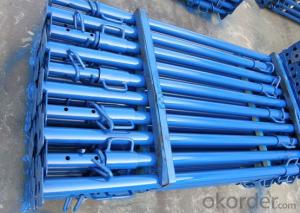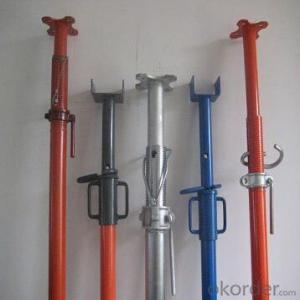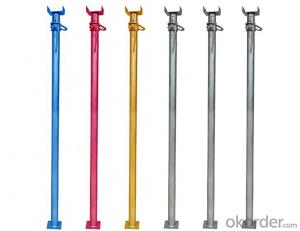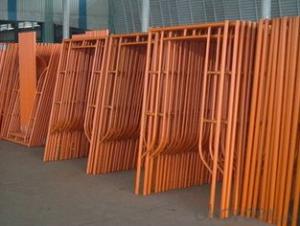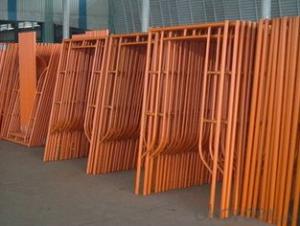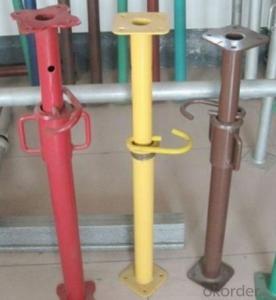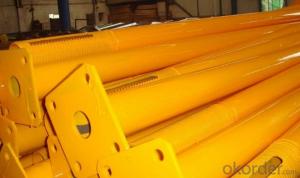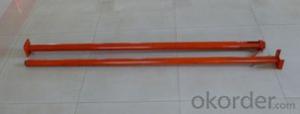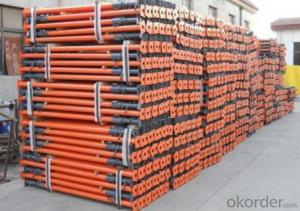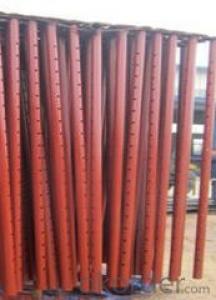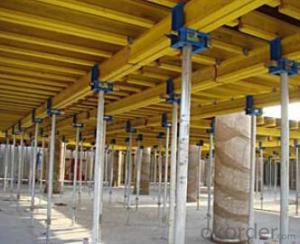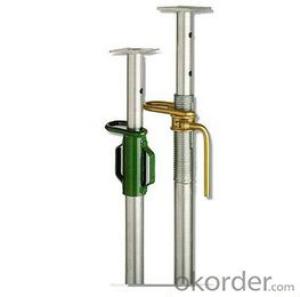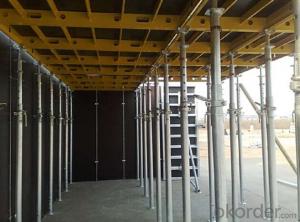manufacturers Scaffolding Steel Prop
- Loading Port:
- China Main Port
- Payment Terms:
- TT OR LC
- Min Order Qty:
- -
- Supply Capability:
- -
OKorder Service Pledge
Quality Product, Order Online Tracking, Timely Delivery
OKorder Financial Service
Credit Rating, Credit Services, Credit Purchasing
You Might Also Like
Quick Details
| Material: | Maint Tube Diameter: | Main Tube Thickness: | |||
| Surface Finished: | Certification: | Color: | |||
| Using Life: | Techique: | Performance: | |||
| Application: |
Packaging & Delivery
| Packaging Detail: | 1.As a practice, steel h frame Scaffolding for sale is bare packed in Container. 2.The packing of frame scaffolding also can be made depend on the customers' need. |
| Delivery Detail: | 10 -15 days after deposit |
Specifications
scaffolding
1.SGS,BV tested h frame scaffolding
2.light frame type
3.best price for sale
4.painting surface, strong welding
| Code | Thickness(mm) | Height(mm) | Width(mm) | Surface Treatment | |
| HF1930 | 2.0/2.2 | 1930 | 1219 | HDG/Painted | |
| HF1700 | 1700 | 1219 | |||
| HF 1524 | 1524 | 1219 | |||
| HF1709 | 1700 | 914 | |||
| LF1700 | 1700 | 1219 | |||
| LF1219 | 1219 | 1219 | |||
| LF914 | 914 | 1219 | |||
| LF1524 | 1524 | 1524 | |||
| LF1930 | 1930 | 1524 | |||
H Frame Scaffolding Accessory
U head jack: 600*34mm/700*30mm solid
Jack base: 600*34mm/700*30mm solid
(the size of nut , head plate can be changed)
walk board:also named planks, 1830mm length, 400mm width, painted
ladder: painted surface, good welded, 2700*442mm
wheel: pp or ruber, 300*150mm/500*150mm with brake
safety net: width:1.8mm, length:6mm. or(L*W): 50*3mm
- Q: Do steel props have any adjustable locking mechanisms?
- Steel props frequently come equipped with adjustable locking mechanisms, which enable users to easily modify the height and stability of the props to meet their specific requirements. The most commonly employed type of adjustable locking mechanism in steel props is a pin and hole system. This system allows users to choose their desired height by inserting a pin into one of the pre-drilled holes on the prop. Once the pin is inserted, it securely locks the prop at the preferred height. Additionally, some steel props may incorporate supplementary locking mechanisms such as a screw or lever mechanism, which enhance stability and security. Thanks to these versatile and adaptable adjustable locking mechanisms, steel props are suitable for a range of construction and support applications.
- Q: Are steel props adjustable for supporting structures with irregular shapes?
- Yes, steel props are adjustable and can be used to support structures with irregular shapes. The adjustable nature of steel props allows for customization and flexibility, making them suitable for various shapes and sizes of structures.
- Q: How do steel props contribute to the prevention of wall and floor cracks?
- Steel props contribute to the prevention of wall and floor cracks by providing structural support and stability during construction or renovation projects. They help distribute the weight load evenly, ensuring that walls and floors remain level and do not experience excessive movement or settling. This minimizes the risk of cracks forming due to uneven weight distribution or structural instability, ultimately preserving the integrity and longevity of the building.
- Q: When to ask for formwork support
- 3, the height of the column in the following 2m must be set up a large cross bar, to maintain the stability of the column; when the height of the column is greater than 2m, should be set up a large cross bar, a large step distance of 1.8m.4, every big pillar template should be set two directions of the bar. At the same time, each 4 upright columns are provided with a pair of scissors braces.
- Q: How do steel props accommodate for uneven ground conditions?
- Steel props accommodate for uneven ground conditions by having adjustable height and width settings. This allows them to be extended or retracted to the desired length and adjusted to different angles, ensuring stability on uneven surfaces. Additionally, their solid steel construction provides strength and durability, allowing them to support heavy loads and maintain stability even on uneven ground.
- Q: How do you determine the number of steel props required for a project?
- Determining the number of steel props required for a project involves considering several factors such as the load-bearing capacity of the props, the height and spacing requirements, and the overall structural design of the project. Firstly, it is important to determine the required load-bearing capacity of the steel props. This can be achieved by calculating the total weight or load that the props will need to support. This can include the weight of any construction materials, equipment, or structures that will be placed on the props. Next, you need to consider the height and spacing requirements of the props. The height will depend on the specific project requirements, such as the height of the ceilings or the number of floors. The spacing between the props will depend on the load distribution and the structural design of the project. Generally, the distance between the props should be such that it evenly distributes the load and provides sufficient stability. It is also important to consider the type and size of the steel props. Different projects may require different types of props, such as adjustable or fixed props, depending on the construction needs. The size of the props will depend on the load-bearing capacity required and the height of the project. To determine the number of steel props required, you can divide the total load by the load-bearing capacity of each prop. This will give you an estimate of the minimum number of props needed. However, it is recommended to add a safety margin to ensure the stability and safety of the structure. This can be done by increasing the number of props or using props with higher load-bearing capacities. Lastly, it is crucial to consult with structural engineers or construction experts who can provide specific calculations and recommendations based on the project's requirements and regulations. They can review the structural design and provide professional guidance on the appropriate number and specifications of steel props needed for the project.
- Q: What are the common maintenance requirements for steel props?
- Steel props require regular maintenance, including cleaning, inspection, lubrication, and proper storage. Cleaning is vital for removing accumulated dirt, debris, and corrosive substances. To prevent rust formation, a mild detergent and water solution should be used, followed by thorough drying. Periodic inspection is necessary to check for damage or wear. This involves examining the prop for cracks, bends, or loose components. If any issues are found, the prop should be repaired or replaced to ensure safe and effective use. Lubrication is essential for smooth prop functioning. Applying an appropriate lubricant to moving parts, such as adjustable mechanisms, reduces friction and prevents premature wear. Maintaining the integrity of steel props requires proper storage. They should be stored in a dry, well-ventilated area, away from moisture and direct sunlight. Proper stacking or securing is also important to prevent accidental damage. Following the manufacturer's guidelines and recommendations for specific maintenance procedures is advisable. Regular maintenance not only extends the lifespan of steel props but also ensures their safe and efficient operation.
- Q: Can steel props be used for temporary or permanent support?
- Yes, steel props can be used for both temporary and permanent support. Steel props are adjustable and sturdy, making them suitable for providing temporary support during construction or renovation projects. Additionally, their durability and load-bearing capacity make them a viable option for long-term or permanent support in structures such as buildings, bridges, and other infrastructure.
- Q: Can steel props be used for supporting temporary bridges?
- Yes, steel props can be used for supporting temporary bridges. Steel props, also known as adjustable steel props or steel shoring props, are commonly used in construction projects to support temporary structures. They are designed to provide temporary structural support and are adjustable in height to accommodate different requirements. When it comes to supporting temporary bridges, steel props can be used to provide additional support and stability. They can be positioned strategically under the bridge to distribute the weight load and prevent any sagging or collapsing. The adjustable nature of steel props allows for precise leveling and alignment of the temporary bridge, ensuring a safe and secure structure. Steel props are made from high-quality steel and are designed to withstand heavy loads. They are typically manufactured with safety features such as locking pins and adjustable heads, which provide added stability and prevent any accidental movement or collapse. This makes them an ideal choice for supporting temporary bridges, as they can handle the weight and stress of the bridge and ensure the safety of the construction workers and users of the bridge. In summary, steel props can be effectively used for supporting temporary bridges. They provide the necessary support, stability, and adjustability required for constructing safe and reliable temporary bridge structures.
- Q: How do you ensure proper stability when using steel props on inclined surfaces?
- Proper stability when using steel props on inclined surfaces can be ensured by taking the following measures: 1. Evaluation of the site: Conduct a thorough assessment of the inclined surface to identify any potential hazards, such as loose or unstable ground, uneven terrain, or any other factors that may compromise stability. 2. Secure anchoring: Ensure that the steel props are securely anchored to a stable foundation or structure. This can be achieved by using appropriate anchoring techniques, such as ground anchors, braces, or tie-backs, to prevent any movement or sliding. 3. Proper positioning: Position the steel props at suitable intervals along the inclined surface to evenly distribute the load. This helps to maintain stability and prevent any excessive stress on individual props. 4. Adequate bracing: Use additional bracing methods, such as diagonal braces or cross-braces, to enhance the stability of the steel props. These braces provide lateral support and help to counteract any potential lateral forces or movements. 5. Regular inspections: Conduct regular inspections of the steel props and their anchoring systems to ensure they remain in good condition. Any signs of damage, movement, or instability should be promptly addressed and remedied. By following these measures, proper stability can be ensured when using steel props on inclined surfaces, minimizing the risk of accidents or structural failures.
Send your message to us
manufacturers Scaffolding Steel Prop
- Loading Port:
- China Main Port
- Payment Terms:
- TT OR LC
- Min Order Qty:
- -
- Supply Capability:
- -
OKorder Service Pledge
Quality Product, Order Online Tracking, Timely Delivery
OKorder Financial Service
Credit Rating, Credit Services, Credit Purchasing
Similar products
Hot products
Hot Searches
Related keywords
